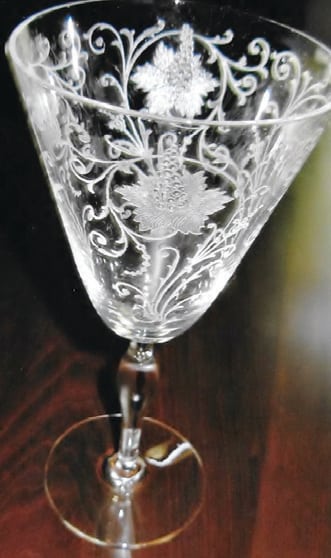Dear Connie Sue,
This crystal glass is from a set left to my 80-year-old husband by his great-grandparents. Could you possibly identify what company made this crystal and the name of its pattern?
Mrs. R., Winchester
Dear Mrs. R.,
Your husband’s crystal stemware was made by Fostoria Glass Company in Fostoria, Ohio. Named the Woodland pattern, it was made from 1922 to 1928.
Dear Connie Sue,
I have two of these lovely old lamps. They are in perfect shape. They were left to me by a woman who had owned them since the early 1900s.
Could you please tell me how old they are and how much they are worth?
Mary Sue, Union City
Dear Mary Sue,
Your tall lamps are called banquet lamps. They were made between 1880 and 1920.
Because they were so stylish and admired, many people electrified the lamps with modern sockets replacing the wicks. The font that held lamp oil remains nestled just below the bulb socket.
Similar lamps typically sell for $250 to as much as $900 each with provenance or outstanding decorative detail.
Dear Connie Sue,
I’ve slowed down tremendously on collecting as I’ve grown older and want to simplify my life.
Many years ago (at least 10), I purchased prints at an estate sale by artists Anna Mary Robertson (Grandma Moses), Guy Coheleach, Ray Harm and Richard Evans Younger. The prints, still with packing, were signed and numbered, purchased from galleries called Regency House Art Inc., The Collector’s Gallery in Huntsville and Frame House Gallery in Louisville.
I thought when I bought them I would mat and frame them, but when I did some research, I realized that some of these prints are worth hundreds, and I, as a novice framer, should not attempt this endeavor. Therefore, they have been stored over the years in a cedar box in my garage.
I would like your thoughts on their value and how best to liquidate them.
Shirley, Manchester
Dear Shirley,
Your dilemma is shared by many of us who have, for decades, carefully stored boxes of something once considered fun to collect. Limited availability was often mentioned while marketing prints like yours. Early online price guides often quoted projected values based on current enthusiasm. And then the party ended.
In reality, only a few of the items produced during that high time of “buy all of these before they’re gone” are currently valuable. But there is generally one or two.
Here’s how I find out.
- Go to eBay.com. In the search bar, type in “Guy Coheleach Regency” (or any of your artists and his or her publisher).
- At the drop-down menu titled “Sort,” choose “Price + shipping: highest first.”
- Go to the left-hand side bar; scroll down to “Show Only” and click “Sold Items.”
This search brings the most-sought-after item to the top and tells you what people have recently paid. Think logically about the information. Scrolling down will help you get an overview of value. If a couple of the prints are selling for more than $100, you might consider consignment or an online auction. You could even offer them to friends through social media or emails.
Also included in the eBay listings will be sales of groupings of prints. These values will help you determine if it might be easier to sell the whole lot for one price.



